Notes
Addie Libby Rundle was a photographer in Spokane, Washington; she ran her studios from c. 1898-1929. This photo in the Washington State Archives is of a young Addie Libby taken in the Curtis Studio in Seattle, Washington, probably c.1902. Addie Libby studied for a few months with the Curtis studio in Seattle.

Here are some examples of photographs from the Libby Art Studio in Spokane Washington. Each photo is in a folder; the photo of the woman also includes a thin protective sheet on top of the photo. You can see the change from the stuio’s mark in the early photos to the development of a signature style mark in the ones from 1916-1917.
Baby – probably circa early 1900s. The photo is in a paper folder/mat.


Woman – in an oval mat within a paper folder (dated 1916).
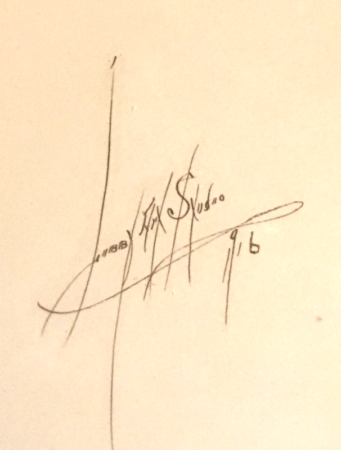
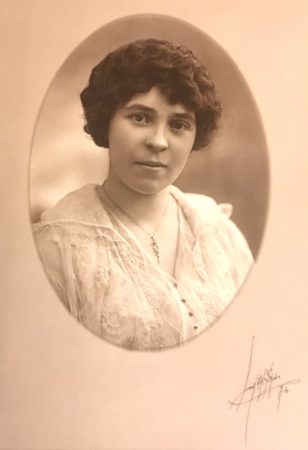
Couple with Baby – in paper folder, undated.
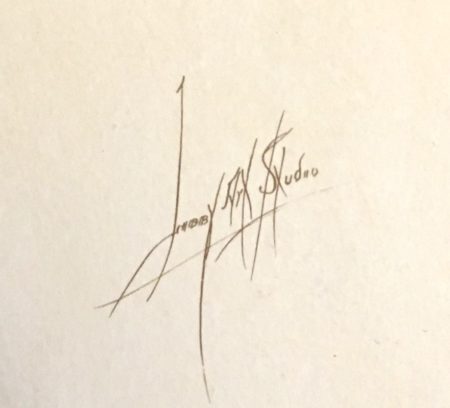
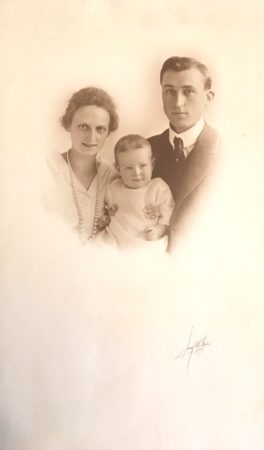
Young man – a large 11 x 14 print, on still paper, unmatted, 1917.
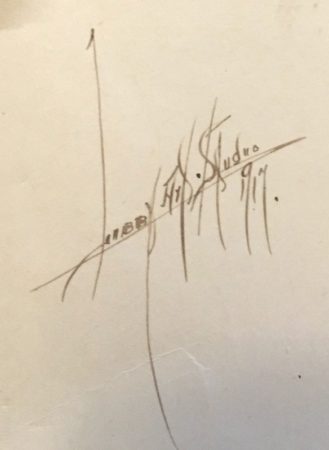
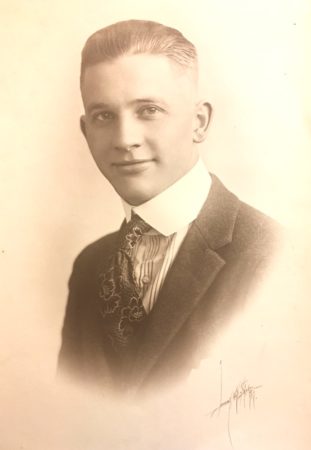
The Libby Studio Photograph Collection is held by the Eastern Washington State Historical Society (Northwest Museum of Arts & Culture), Spokane, Washington. Click here to see the 100 digitized photos from that collection, which appear to be by either Addie’s brother Charles Libby, or his son, Charles Libby, Jr.
BTW, the other “Miss Libby” – Minnie Libby from Norway, Maine, was featured in this podcast episode: 14 The Unforgettable Miss Minnie Libby
Lifeline
Recommended Links
- Ancestry.com (census records, city directories, and more; paid account required – Visit
- Family Search website has U.S. Federal Census and more; free account required – Visit
- Geneologybank.com has a selection of digitized newspapers from the United States; paid account required – Visit
- Newspapers.com has a selection of digitized newspapers from the United States; paid account required – Visit
- Newspaperarchives.com has a selection of digitized newspapers from the United States; paid account required – Visit
- Peter Palmquist database at the Yale Beinecke Library – Visit
Transcript
You’re listening to Photographs, Pistols & Parasols.
Support for this project is provided by listeners like you. Visit my website at p3photographers “dot” net for ideas on how you, too, can become a supporter of the project.
Welcome to Photographs, Pistols & Parasols, the podcast where we celebrate early women artisan photographers.
I’m your host, Lee McIntyre.
In today’s episode, we’re going to try to untangle some narrative threads as we meet Addie Libby Rundle, a prolific and talented photographer from Spokane, Washington in the early 20th century.
For more information about any of the women discussed in today’s episode, visit my website at p3photographers.net.
That’s letter “p”, number “3”, photographers “dot” net.
*******
Hi, everybody. Today we’re going to meet a woman named Addy Libby. Actually her married name was adding Addy Libby Rundle, but as we’ll see, she used Addy Libby professionally throughout her career.
She lived in Spokane, Washington, and back in the late 19th, early 20th centuries, it turns out that there were at least 24 women who ran photography studios [in Spokane]. And I say “at least” because that’s how many my husband and I have discovered so far in our research.
Now, we’ve also discovered 45 women in Seattle, so that’s twice as many as in Spokane, but Seattle, even back then was considerably bigger than Spokane. So it’s really been astonishing to have uncovered 24 early women artists and photographers in Spokane.
Today, I want to introduce you to one of them. And her story is quite interesting because it also involves a couple of other studios that were around at the same time, but we’ll get to that in a second. Now, the woman I want to introduce you today is a woman named Addy C. Libby. She started life as a young socialite in Olympia, Washington, but she had opened her own studio in Spokane, Washington by 1900 at the latest.
Well, little bit more about the date of her studio in a second.
Now initially, her studio was just named after herself: A.C. Libby. Photographer is how it reads in the Spokane city directory.
By 1903, though the studio had been renamed to Libby’s Photographic Art Studio, Miss A. C. Libby, Proprietor.
Now the name subsequently gets simplified few years later to just the Libby Art Studio. Addy Libby runs that studio on her own starting in 1903 until 1913 when she marries her assistant, a man named T. William Rundle. Mr. and Mrs. Rundle run that studio together until his death in 1927, when Addie continues on all on her own.
Interestingly, though, not only in the studio still just called the Libby Art Studio, Addy Libby continues to list herself separately in the residence listings as well, bringing attention to her studio twice in the listings. And she’s also been listed as the wife of William T. Rundle in the residence listings as well.
So she’s listed several times in the directories.
Now her husband’s name is listed in the directory as William T Rundle, [but] in the marriage notices he is always listed as T. William Rundle. Don’t ask. Mr. Rundle seems to go by “Thomas William” or “William Thomas” interchangeably.
Anyway, in Addie Libby Rundle’s own lifetime, the Libby Art Studio is acclaimed for its studio and artistic portrait photography work. I mean, to quote from one social notice that appears in the newspapers when she’s off visiting friends in Olympia, it says, “Mrs. Rundle has the Libby Art Studio in Spokane, which is known all over the coast.”
Also an ad for the Libby Art Studio in the 1920s. Spokane city directory proclaims. “The studio that has made the name Libby the standard for good photographs.”
Unfortunately, the Spokane newspapers haven’t yet been digitized, and so it’s not easy to put together a complete picture of **edit Abby of ** Addy Libby Rundle’s life like I can for some of the other women for whom we have more information from the newspapers.
But it is still fairly easy to put together some basic information for Addie Liddy.
Now, she wasn’t the first woman to open in a studio in Spokane, Washington. And she wasn’t the only photographer with the last name of Libby in Spokane, Washington.
But she was the first Libby to open a studio there. And judging from, the city directories and the mentions in the newspapers from her hometown of Olympia, she was — in her own time period — the most successful Libby [photographer] before her retirement around 1930.
But what’s interesting is that over time, and with the assistances of some unfortunate misinformation in her nephew’s obituary in the 1970s, the story of the Libby Art Studio in Spokane has been co-mingled with the story of Addie’s brother’s studio in Spokane … to the extent that it appears the historical record has been a little bit remiss by overlooking the contributions of Addie Libby and her separate studio.
Because most of the stuff that you find online about any Libby studio in Spokane talks about a single studio run by her brother Charles Libby.
Now, to be sure, Charles Libby did run a studio in Spokane starting in 1903, the same time Addie opened her Libby Art Studio. And Charles did outlast (and outlive_ his sister there in Spokane.
But in fact, Charles actually started his career in photography working for his sister’S studio in Spokane, [perhaps] sometime a little before 1900. In 1903, when she rebranded her studio is the Libby Art Studio, Charles left her studio and went off and opened his own studio. competing with her, but running [his] studio for commercial photography, called just the “C. A. Libby Studio”. ((And sometime later changed the name to the Charles A Libby studio.)
Charles doesn’t ever advertise in those early days as doing the kind of studio and portrait work that [Abbie’s] Libby Art Studio is known for. That type of studio work is done by Charles [at his studio] only after his sister Abbie retires in 1929.
1929 is actually the moment when Addie’s brother, Charles, is joined by his son, Charles Jr, and then those two men together run the Libby and Son studio, which advertises both commercial photography and portrait work.
I have to think that perhaps Addy trained her nephew to take over that area of the business since Charles had spent two decades apparently not doing that kind of photography.
As I said, Charles last much longer than Addy. Addy seems to retire around 1930, while Charles continues on into the 60s. In his obituary in 1966, it explains that ,
“Charles A Libby went to Alaska as a teenager and worked on the Yukon railroad for a year before coming to Spokane in the fall of 1898. There he joined his sister, Addie Libby, in the Libby Art Studio, art studio, and was associated with her until 1901 when he opened his own studio in the old Bavaria Block on Post Street.”
Well … that’s sor t of true. I mean, according to the Spokane city directories Charles works for the A.C. Libby studio in 1901. In 1902, t hey’re actually partners in a rebranded studio called “Libby’s” which perhaps reflects the fact that both Libbys are working there. That change also might have happened toward the end of 1901 when Addie Libby took the opportunity to go off to Seattle for a while to study with — as the newspaper calls him — “Curtis, the Seattle photographer.”
Now for those of you who know a little bit about early 20th century photography, “Curtis in Seattle” here means Edward Sheriff Curtis; he later became very famous for his North American Indian project, which he started around 1906. But prior to that in Seattle, he actually had an artistan studio, and it would within the type of thing that photographers did all the time, to go off and learn from a particularly famous or well known or well respected and admired photographer.
intriguingly, there’s a photo of Addie Libby that was taken by the Curtis studio. Perhaps it was taken there in 1901, when she went off to study with Edward Curtis. Tthere’s no specific date even for [that portrait of Addie Libby]. I’ll put a link to it and a reference for it in the Episode Notes for today’s episode, because it’s fun to see it.
But it’s also intriguing that she had this connection to Edward Sheriff Curtis, who of course, became a more famous photographer.
Anyway, Addie returns to Spokane in early 1902 from her studies in Seattle with Curtis, and Addie and Charles are running, as I said, the Libby’s Studio in 1902. But then, in the 1903 directory, we find them running those competing studios, the Libby Arts Studio, which is Addie’s, and the Libby Studio for Commercial Photography, which in 1904 following the just bears Charles’s name.
Interestingly, the Spokane directory for 1897 doesn’t list either sibling, so I don’t think they’ve moved to Spokane then. And unfortunately, the digital copies of the directories online for 1898, 1899 and 1900 are either incomplete or missing completely. Which is why it’s really hard to pinpoint the moment when Addie opened her studio, and Charles actually moved to Spokane.
But in the 1900 census, Addie Libby and her brother Charles are both listed as photographers. Unfortunately, the 1900 census didn’t ask to indicate whether or not they were working on their own or for someone else. Sometimes you find that kind of information in the census, but not in 1900.
But certainly based on the census, both Addie and Charles are working as photographers in Spokane in in 1900.
Unfortunately, I haven’t found anything to indicate if it’s really true that Addie was in business as early as 1898, which is what Charles’ obituary would imply.
However, I have found evidence from the society notices in the Olympia newspapers that Addie actually moved to Spokane in 1898, but was working in a department store at first.
And in August of 1898, and continuing through mid October, Addie Libbyis the front runner in the race to become the “1898 Chrysanthemum Carnival Queen”.
Unfortunately, for Eddie, there was a lot of last minute jockeying, and whatever shenanigans in the polls, and at the very last moment, the owner of the newspaper that sponsors that competition shows up [during] the counting of the votes with a 3000 vote block for another woman, which was enough to deny Miss Addie Libby the crown.
However, Miss Libby does take a star turn as a performer at the Chrysanthemum Carnival’s opening ceremonies in November of 1898. The description in the paper says that her beautiful soprano was soaring on her rendition of something called “The Arrow Song”, a performance of which elicited repeated calls of ‘encore, encore’, and afterward she received numerous bouquets of flowers.
All right, but I digress there. Although I’ve always find it fascinating to read about this type of goings on back in the day when we’re reading about these women. I mean, the idea of a newspaper sponsoring a sort of beauty and popularity contest is really quite fascinating. And I have run across that before with another early artisan photographer.
And, according to the articles, this wasn’t something that was free, it costs 10 cents to vote — the idea being that they were raising money [through the voting]. And so at the end of this contest for the chrysanthemum Queen, more than $900 had been raised from more than 9000 votes.
But getting back to Addy Libby as a photographer, as I said, there’s no real indication of when she officially opened her studio, but at least by 1900, she’s definitely listed as a photographer in the census. And then in the 1901 directory, she’s already running her own studio.
Before 1902, her brother Charles is listed as just working for her. So I think it really was not until 1902 that he really joined her as a full partner in the studio, and then went off on his own.
As I said, though, Charles did have the much longer career. He opened his studio then in 1903. His son Charles Jr, joins him in 1929 as “Libby and Son”.
Charles Libby (the brother) dies in the 60s, and Charles Jr. continues the business for a few more years, until about 1969.
Now, there’s another quote that I found in the Washington State Archives online about the Charles Libby’s studio. It says Charles, “he began his career working for his sister Addy in the Libby Art Studio. He opened his own studio in 1901.”
Well, side note here, again, I can see that he opens that studio in 1903.
And Charles A. Libby never actually worked for the “Libby Art Studio”, because the Libby Art Studio was a name that it became when Addie went off on her own.
So I emphasize these things now, because I think it’s really important as we look at the historical record, to make sure we acknowledge the work that was done by these early women photographers.
I mean, Addie actually ran that studio for almost 30 years. She was in business for over 30 years in general. And so, I think it’s really key to make sure that her accomplishments get acknowledged in a way that the moment they seem to be conflated underneath her brother’s accomplishments.
And he was very accomplished, I mean, he did work that catalogued information about the early days in Spokane.
Part of what’s happened I think, with historical record is also confused by the information that’s in Charles Jr’s obituary when he dies, because in that obituary, it gives all the credit for the Libby studios in Spokane entirely to Charles, the brother of Addie, the father of Charles Jr. It’s really unfortunate that Charles Jr.’s obituary doesn’t acknowledge his Aunt Addie’s contributions at all.
But Addie’s skill was incredible.
Chris, and I had a chance to go to Spokane a few weeks ago. And in antique stores there, we ran across some beautiful examples of her work.
I mean, they’re really remarkable. I’m going to include some pictures of them in the Episode Notes. They’re just wonderfully clear, beautiful prints that are portrait of men and women, signed as an artistic photo, and put in a beautiful mattes, really oversized, which is really interesting to find. These aren’t the standard eight by 10 or smaller images. They’re actually quite large.
And some of them actually have dates on them from either the mid teens or the early 1920s.
And that reminds me, I should go back and mention a couple more things about Addie’s husband, “Thomas William Rundle”, or as I said, [sometimes known as] “William Thomas Rundle”. He’s the photographer that Addy marries in 1913. According to their wedding notice, Addie Libby marries T. W. Rundle in 1913 in San Francisco. There’s no particular reason given why they got married in San Francisco, since they were living in Spokane.
The notice actually mentions that Mrs. Rundle runs the Libby Art Studio, and her husband has been working as her assistant at that studio for the two years prior to their marriage.
I think there’s another notice that said they were in San Francisco, or going to San Francisco, to visit friends. So somehow they decided to get married while they were there?
We haven’t done a lot of research into Addie’s husband, but someone actually posted a short biography of him on a Find a Grave page that they put together. And it mentions that Addie Libby was Thomas William Rundle’s 4th (!) wife. Here’s a quote from tha .. from the Find a Grave page, it says [paraphrase]: Thomas William Rundle, also known as William Thomas Rundle, was raised by his parents, Henry and Clara Rundle in Edwardsville, Illinois. William followed his father and older brother Edward, into their profession of photography. He was married four times to four different women, including at A. C. Libby.
Now, that’s really intriguing. I mean, in a quick search, I actually can’t find any of that information right off.
But I have to believe that the person [who did the Find a Grave page] actually found it because they mentioned that Thomas William Rundle died in New Mexico, and that it was on his death certificate.
And we did find his death certificate online.
Yes, you actually can find New Mexico death certificates (historical ones), online.
So it’s intriguing. He dies in New Mexico in 1927, although he’s still listed in the Spokane city directories from 1926. Unfortunately there’s no Spokane directly for 1927.
But on the death certificate, it says that he died in New Mexico of natural causes. His wife, Mrs. A Rundle is the informant.
And interestingly, he’s being buried in Los Angeles, not back in Spokane.
Again, it’s not clear what’s going on here from what I found so far, but I haven’t yet had a chance to do a deep dive to find out his full story. I’ve got to wonder if Addie and T. William were separated in 1927, or whether he was just there on business and happened to die.
I also don’t know if him being buried in Los Angeles, and not buried in Spokane, would indicate he was buried with his parents.
All things that will need to be explored at some point.
So that’s one area of inquiry that has some intriguing puzzles to uncover.
If we go back to the Libby’s in Spokane, we have another thing that makes it even a little more puzzling and confusing, because I didn’t mention that Addie and Charles had an older brother named George.
Now he’s living with them in 1900. He’s actually the head of the household in that 1900 Census, because their father had actually died in 1898.
So in 18, sorry, 1900, all four of the siblings — (there’s another sister named Ruth) — all of them are living together with their mother, and they’re in Spokane.
George H. Libby, Addie, and Charles’ brother, is never a photographer. He is always bookkeeper.
However, in Spokane, at the same time, there is a physician named George W. Libby.
And his son, George W.Libby, Jr. … well, he’s a photographer, running his own studio that competes with Addie and Charles into the 1920s.
I mean, in that ad I mentioned for Addie’s studio in the 1920 directoru, t here’s actually another note at the bottom of the ad that says, “Make careful note of the address.”
And that’s really understandable, since the name “Libby” wouldn’t be enough. I mean, for many years, there are three “Libby” studios at the same time in Spokane, one run by Addie, one by her brother Charles, and one by this other guy, George W.
Well, I know what you’re thinking: Is George W. related somehow to Addie and Charles?
Again, this is another area for investigation. We haven’t yet found anything to indicate there’s a real connection between the two Libby branches. But that doesn’t mean they weren’t connected at some point in time. And it is intriguing that George W. ‘s father, and Addie’s grandfather were both born in Maine.
And all of the Maine ancestors for the people there in Spokane are from the same part of Maine that a woman named Miss Minnie Libby was from; MIss Libby, you might recall. was that marvelous photographer from Norway, Maine in the early 20th century.
Well Miss Minnie Libby – she lived in northern Maine, and that’s the same part where the relatives of all these Libbys in Spokane came from.
Miss Minnie Libby is a contemporary of Addie professionally.
But, it’s not really clear that there is a family connection or any kind of connection between them.
It may just be a coincidence that we have all these photographers named Libby, who seem to have connections to Maine and Spokane. It may just be a coincidence, but to quote something from Agatha Christie, “Any coincidence is worth noticing. You can throw it away later if it’s only a coincidence.”
So for what it’s worth, I’m noticing today this odd coincidence of so many photographers named Libby.
In any case, let’s get back to Addie Libby Rundle. I truly was impressed when I ran across the examples of the photographs produced by her studio. The quality of her work and the attention to detail and styling in these portraits is truly remarkable.
But then I was also kind of surprised and saddened to read in various archive sites online that the only Libby studio in Spokane that gets any recognition in the historical record is the one run by Charles Libby and his son. But it is clear when you look in the directories that Addie Libby ran a photography studio all on her own.
Her brother Charles ran a competing studio. But only one of those studios was called the Libby Art Studio. And the only photographer named Libby who worked there was a talented woman named Addie Libby, later Addie Libby Rundle.
So now you know the full story of the Libby studios in Spokane.
*****
In the Episode Notes today, I’m going to put a link to the Libby Studio Photograph collection. It’s a collection held by Eastern Washington State Historical Society at the Northwest Museum of Arts and Culture.
Now, they have a great deal of information about Charles Libby and his son, Charles, but not a lot of information about Addie Libby. However, I’ve talked with the archivist there, and she’s already planning to do some more work on Addie. So that was great to hear!
And so, I’m really hopeful that we’ll have some more information to report about Addy later this year, as they look into the archives more.
One of the things that they did already do was a pilot digitization project back in 2010, in conjunction with the Washington State Archives, and they actually have 100 samples of Charles Libby’s studio work that you can find on their internet site. And again, I’ll put a link to that in the Episode Notes.
One other thing they have, there is a lot of Charles Libby’s studios, ledger books, which really would be fascinating to go through, and also see what other bits of information, maybe letters, maybe other pieces of paper that were saved along with that collection. The Libby collection archive sounds like a real treasure trove! I can’t wait to talk to the archivist again, and also have an opportunity to go to Spokane, to visit the archive and see some of these materials for myself.
As far as I can tell, though, they don’t have any of Addie Libby’s photos, or at least not catalogued and available online. However, as I mentioned, my husband and I did run across four beautiful prints by Addy Libby at her Libby Art Ctudio.
Let me just briefly describe them because they’re really kind of unique.
One is a little sort of cabinet card size thing — more like a four by six image. But it’s a very cute baby with a whole lot of personality in the photo. Now the baby is shown in the ubiquitous white gown. But this baby is sitting up all over themselves. And it’s a little bare feet and toes are peeking out. We don’t see that a lot in a lot of the baby pictures from the late 19th century.
There’s also a really lovely portrait of a woman, which is more like a five by seven image. But it’s matted in an oval matte and a folder with a special sort of textured sheet of maybe almost an onion skin paper that serves as a protector for the photo that’s underneath.
There’s also a lovely photo of a young man and woman holding their baby, and it almost seems like it’s an informal picture, more like something you would see today. Except it’s clearly a studio portrait because they are posed in the same way as the woman in the Oval Matt. But the man and woman and their baby are in a vignette on the image itself that almost takes the shape of a heart.
And finally, we found a spectacular 11 by 14 print of a young man. It’s a formal portrait. But the personality that comes through not only on his face, but all the visitors and Addie Libby’s images really testified to her mastery of the technique of taking these portraits. She clearly was able to put people at ease. And I think that the Libby Art Studio was very probably — as that notice said — well known for the quality of its portrait work.
Anyway, I’m happy to be able to share these four images that my husband and I found in an antique store in Spokane, Washington. And I’ll put those in the Episode Notes for today’s episode.
As always, you’ll find all this information at p3photographers.net; that’s letter “p”, number “3”, photographers “dot” net.
If you have any questions or want to just drop me a line, send an email to podcast at p3 photographers dot net.
And don’t forget, you can follow Photographs, Pistols & Parasols over on facebook at facebook.com/p3photographers.
As I mentioned, I’m hoping that I’ll have some more information about Addie Libby at some point later this year, after I talk again with the folks at the Northwest Museum of Arts and Culture.
But that’s it for today. Thanks as always for stopping by!
Until next time, I’m Lee and this is Photographs, Pistols & Parasols.
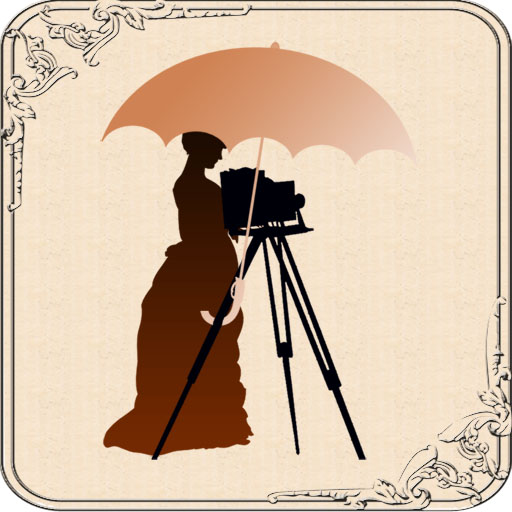

1 thought on “41 – Addie and the Libby Art Studio”
Comments are closed.